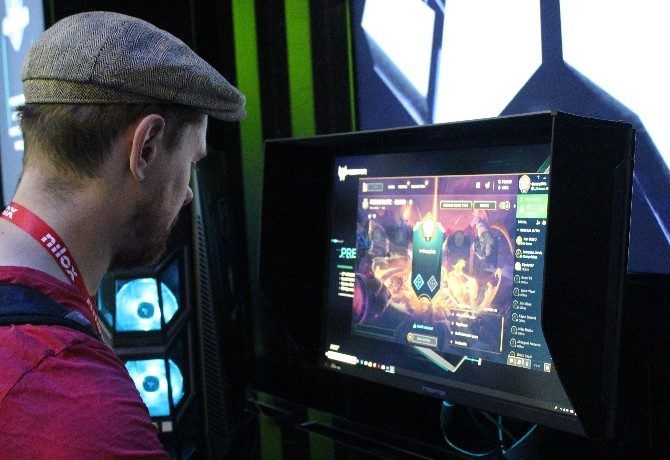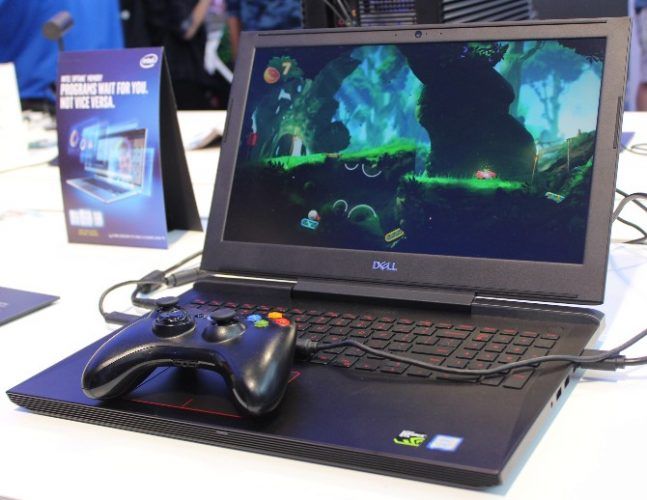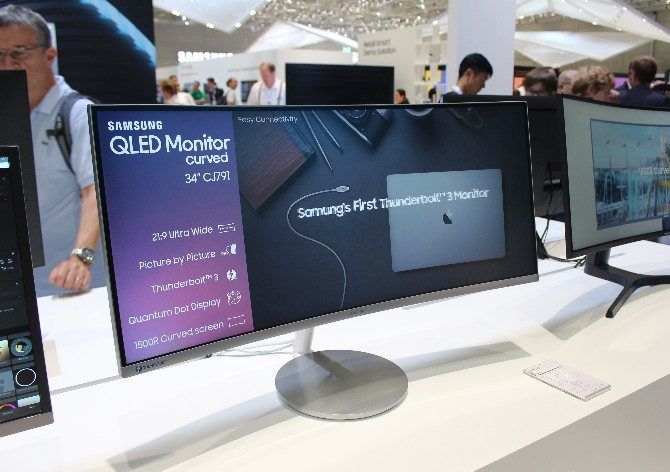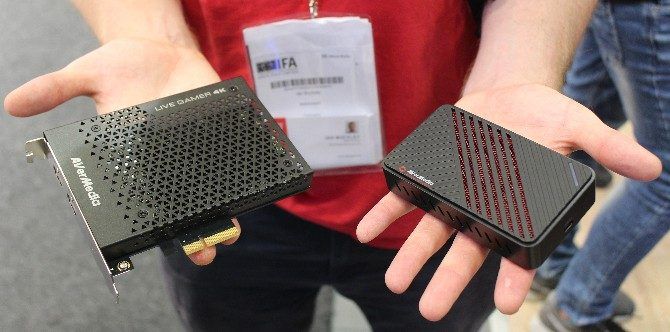There were few new announcements in Gaming at IFA 2018. a few notable exceptions , most companies used their space to showcase their already existing product lines.
Here is a run down of the best things on show for gamers at IFA 2018.
Note: This article will be updated as the conference goes on.
Acer
Thronos

The announcement with the most buzz at IFA 2018 was Acer’s new gaming chair. The “Thronos” was only unveiled to press in the days leading up to IFA and was absent for the rest of the conference. Here is what we know:
Standing at over 1.5 meters tall and capable of sustaining 3 27” gaming monitors, the Thronos is imposing. Black steel, accented in blue or white, cage the user in a n adjustable chair capable of leaning back to 140 degrees. The bottom of the mount contains space for a Predator PC case, and also dynamic response to in game sounds. In short, you will feel every in game impact.
The concept of all-in-one gaming chairs is nothing new. The Thronos seems to have struck a chord and the idea of a self contained “gaming cave” has arrived to stay.
There are no details as to release date or retail price at present. Rumors put the cost at up to $5000 dollars, making this already niche product even more exclusive. That said – serious gamers are unlikely to let price get in the way of what seems to be the ultimate gaming experience.
Predator XB273K Gaming Monitor

Acer also showcased their new Predator XB273K monitor. Aimed specifically at gamers and their needs, it comes with all the features you would expect of a high end monitor. With a resolution of 3840 x 2160 and a refresh rate of 144Hz it promises great image quality.
A budget conscious alternative to the Predator monitor comes in the form of the Nitro XV273K. Aimed at giving a high budget feel at a better price (yet to be announced), it comes in several forms. The 3 announced variations are the XV273K, XV273U (both 27” IPS^3 displays, and XF272U (WQHD).
With each model featuring Acer’s VisionCare(TM) tech, even the lower range models seem a pretty good prospect for the budget minded gamer. The XB273K with be available at EU 1299 during the fourth quarter of 2018.
RAZER

Razer were promoting a trio of peripherals under the slogan “Raise the Level Cap”. What this meant in practice was a hands on experience of their new gaming mouse, keyboard and headset. Each was newly presented at IFA 2018.
Kraken Headset
The new Kraken headset was designed with both quality and comfort in mind. An inline controller on the USB cable controls not only volume, but bass level – something they were keen to point out is unique at this price point.
Sound is taken care of through 2 balanced drivers per ear designed to give equal response across all volumes for accurate positioning. The Kraken headset is also the first to make use of THX spatial audio. The virtual positional audio system gives a far greater depth to directional audio, and from the small demo provided is a marked improvement to other budget headsets.
Retailing at $99, the headset certainly had the feel of something more expensive, and the design around the eyes is designed to keep the user cool. Notched ear padding for glasses wearers and a 3.5mm jack input into the USB adapter show that this headset has been thoroughly thought out with user comfort and practicality in mind.
Black Widow Elite Keyboard
The Black Widow Elite keyboard brings a new programmable system to the table. A mod key gives the user a second keyboard layer which can be assigned to any key combination or macro. Media keys have also been added to the top right of the keyboard along with a notched radial dial and button. While they are designed as media and volume keys, they are fully programmable from Razer’s Synapse softtare controller. On board keyboard memory can store these macros making up to 5 custom keysets plug and play regardless of what computer you plug into.
Razer have also modified their switches, adding walls to them stopping any key wobble or false hits. The effect this had was impressive, as running your finger across the keyboard caused no sideways movement at all.
Again the thought and comfort are apparent here, with an easy to adjust magnetically attached full leather wrist pad, and a cable channel to route the cable out from either side of the keyboard. The previous Black Widow Elite retailed at $179.99, and while the new edition is cheaper, $169.99 is still a high price for many. This keyboard is feature packed, and while it’s impossible to tell from a few hands on minutes, seems worth it.
Razer Mamba Wireless Mouse
Initially released in 2010, the Razer Mamba Mouse was originally touted as indistinguishable from wired mice. The 2018 update ups the ante again, with an improved battery life and a new 5G optical sensor (requested by pro-gaming Razer users allegedly). Much like the Black Widow, the mouse has onboard memory, and programmable buttons. The same mod system is in place allowing a mod button to give each other button multiple functions.
Battery life is claimed to reach over 50 hours, and a micro USB cable takes care of charging while allowing the mouse to function as a standard wired mouse. It will retail at $99, putting it squarely in the middle of the field in terms of premium wireless mice.
Razer were very keen to impress upon us the differences these new peripherals have, and from what we have seen these are well thought out changes designed to give more functionality at a similar or lower price point.
Dell

Dell showcased the recently released G3 line of gaming laptops, which function as a cheaper alternative to the G5 and G7 range. Starting at $799 with an Intel i5-8300H and topping out at $999 for an i7 they claim solid performance on a budget. While clearly less powerful than their Alienware counterparts, the G3 played well. The main difference outside of processing power and minor aesthetics is the display. The G5 is available with an ultra high definition (UHD) display much like it’s predecessor (The Inspiron 15 7000). The G3 IPS comes with a perfectly capable IPS, but no option for upgrade.
Also showcased was the new S2719DGF 27” Gaming Monitor. With resolutions up to 1440p, and a reported refresh rate of over 150Hz it is designed with high end gaming in mind. The monitor in action looks fantastic, but even more impressive is the price. According to a Dell representative, the 27” edition will retail at around 420 Euros (around $487) with 24” model available for around 250 Euros (around $290). If these prices are true, this is a lot of gaming monitor for your money.
Alienware

Alienware were showcasing their revamp of the Elite Gaming Mouse. Designed to adapt to any user, it is incredibly customizable. The sizes connect magnetically to the mouse allowing users to change mouse widths on the fly. Another advantage to this feature is that the thin mouse has two thumb buttons while the wider mouse has 4 (not pictured here). The chassis is capable of taking two sets of weights for optimum control over the feel and balance of the mouse, and the top of the shell is retractable for different hand lengths.
Alienware also were showcasing the new AW988 headset , described as the “gaming headset for the most dedicated audiophile.” While the display model was not able for testing, it was surprisingly light and above all – comfortable.
Of course, this is Alienware, so everything had RGB LEDs, which are fully customizable from the Alienware Command Centre software. The recent range of Alienware laptops boast the high end gaming specs we have become accustomed to, and strike a nice balance aesthetically between the larger than life previous models and standard laptop cases.
Samsung

Samsung launched the CJ79 34” curved widescreen monitor. While not touted specifically as a gaming monitor, it is the first of it’s kind to support a Thunderbolt 3 connector. Users of Razer external graphics cars will be ale to chain their gaming laptops to the monitor. laptops The 3440 x 1440 screen is capable of supporting dual display sources, and a larger CJ89 monitor has also been announced. Currently neither monitor has a retail price.
AverMedia Capture Cards

A smaller booth at IFA this year was home to AverMedia, showing their latest line in capture cards.
With streaming more popular than ever, AverMedia’s latest capture cards are aimed both at dual PC streaming and PS4 Pro players. The GC573 is an internal capture card capable of 4Kp60 High Dynamic Range (HDR) recording – something they claim is unique. Meanwhile their GC553 Live Gamer ULTRA external capture card provides pass-through 4Kp60 HDR, and recording at 4Kp30. Both cards claim ultra low latency – under 60ms was the figure claimed by a representative.
If these cards can do what they say they are a new standard in capture cards, and we hope to review them in future.
Gaming at IFA 2018
Gaming was somewhat underrepresented at IFA, but given it’s proximity to Gamescom this wasn’t too much of a surprise. What was on show was still impressive, and whether you need a gaming throne or a cheap but high quality monitor you’re well set with what IFA 2018 had to offer.
Read the full article: Gaming at IFA 2018: What’s New and What’s Hot?
from MakeUseOf https://ift.tt/2wvPxUg

![]() Alana Semuels / The Atlantic:
Alana Semuels / The Atlantic:
















